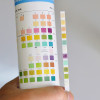.jpg)
 IJCP Editorial Team
IJCP Editorial Team
Predictors of Ventilator Associated Pneumonia in Preterm Neonates Admitted in a Special Newborn Care Unit
A new study aimed
to assess the usefulness of microscopic examination and culture of endotracheal
aspirate (ETA) in the early diagnosis of ventilator-associated pneumonia (VAP)
in preterm neonates.
This prospective, observational study included 80 neonates with a gestational age below 37 weeks, requiring
mechanical ventilation for at least 48 hours in a Special Newborn Care Unit
(SNCU). VAP diagnosis followed the Centers for Disease Control (CDC) criteria.
Out of the
neonates enrolled, 58.5% developed VAP––resulting in an overall incidence of
74.7/1000 ventilator-days. ETA culture demonstrated a shorter time to diagnosis
compared to CDC criteria, with a sensitivity of 80.8% and specificity of 72.7%.
Outborn delivery emerged as the primary risk factor for VAP, and
multidrug-resistant Klebsiella pneumoniae was the predominant organism.
From the findings, it was inferred that in their high VAP incidence unit, ETA culture and microscopy provided an early diagnostic opportunity compared to CDC clinical criteria, emphasizing the effectiveness of these methods in identifying VAP in ventilated preterm neonates.
Source: Pahwa S, Sethi A, Kaur G, Dhir
SK, Jindal N, Rai S, Jindal S. Indian Pediatrics. 2024 Jan;61(1):45-8.

IJCP Editorial Team
Comprising seasoned professionals and experts from the medical field, the IJCP editorial team is dedicated to delivering timely and accurate content and thriving to provide attention-grabbing information for the readers. What sets them apart are their diverse expertise, spanning academia, research, and clinical practice, and their dedication to upholding the highest standards of quality and integrity. With a wealth of experience and a commitment to excellence, the IJCP editorial team strives to provide valuable perspectives, the latest trends, and in-depth analyses across various medical domains, all in a way that keeps you interested and engaged.












Please login to comment on this article